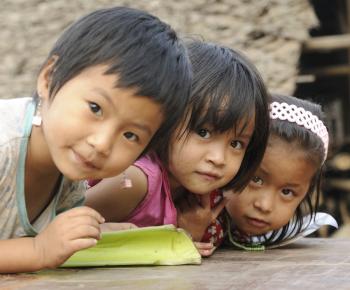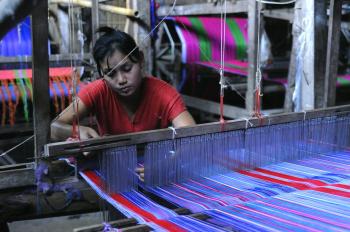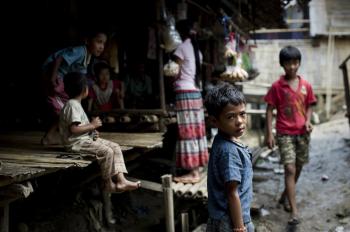After the Burmese military took control of Burma in a coup in 1962, they began a suppression campaign against local ethnic groups, pushing them to the edges of the country. Since 1975, Burmese refugees from the main ethnic groups—Karen, Kachin, and Shan—have been fleeing to Thailand to escape the violence. They took shelter in temporary settlements just across the border, and could often return home when the fighting subsided.
In 1984, however, a major assault on Karen State sent some 10,000 refugees into Thailand, many have been there ever since—raising families, living in limbo, dependent on foreign aid.
By this time it was clear that the oppression in Burma was not going to end soon, so the Thai government consolidated the villages into refugee camps.
Today, nearly 150,000 people live in nine camps along the over 2,000-kilometer (1,250-mile) border with Burma. In the eyes of the Thai government, their residents are not “refugees” but “displaced people,” since Thailand does not recognize the legality of refugees.
This puts the refugees in a situation of suspended animation. Although they can stay for an unlimited time in the camps, they cannot obtain permanency in Thailand. Thailand only provides temporary shelter to the oppressed, acting as a buffer until they can be resettled to a third country with the help of the United Nations High Commission for Refugees (UNHCR). This can take years and is a solution for some, but not all.
Tha Lai: Safe but a Hard Life
“I spent 15 years in the Mae La Oon camp, after being oppressed and discriminated against by the Burmese military,” said Tha Lai, a former Karen refugee, now living in Lancaster, Pennsylvania.
With the help of an interpreter, Tha Lai shared his story over the phone.
“While I lived in Burma, I had a happy life with my family. In 1992, [the] Burmese military started demolishing and firing on villages; they went from one village to another, chasing people out of the village, firing on the houses, and killing people. They came to my village, so we had to run for our lives in order to survive. We didn’t have much rice and could not take anything with us, as the attack on the village was very sudden. I had to seek refugee status in Thailand, fearing that otherwise [the] Burmese military would arrest and kill me.”
Although safe, the camp was still a hard place to live. All refugees in the camp had to obey Thai laws and were not allowed to exit the camp.
“Many refugees tried to go outside of the camp to get money to live a better life, and then they were caught and imprisoned.”
Tha Lai says [the] Thai government allows refugees from Burma to stay on its territory, as long as they obey Thai law. But the intention of Thai authorities is that once Burma obtains democracy, they will send everyone back.
Tha Lai, now 60, was lucky enough to be resettled in the United States in Nov. 2009 with the help of the UNHCR. Although he is not sure he will go back to Burma, he has hopes that his children will have that chance one day.
Kawthoolea Moo: Future Lawyer
Kawthoolea Moo (pseudonym), 37, spent more than 10 years of his life in a camp.
“In the camp it felt like being under house arrest. We could not go outside the camp. If we went outside, Thai authorities sent us to jail. We felt we had no right to do anything. If you want to go outside, you need to ask for permission from the camp commander. … But when you go outside, other Thai authorities can still arrest you.”
Kawthoolea Moo admits he sometimes felt insecure in the camp being so near the border. The Burmese military can enter the camp anytime as spies, pretending to be refugees.
“We had to be careful all the time. The Burmese military want to destroy Karen people, because Karen people want independence from Burma and want to live in a democracy. In the camp, life is meaningless, and people have no hope for the future.”
In November 2009, Kawthoolea Moo came to the United States, with the help of UNHCR. He lives in New York.
“They came to the camp in 2005 to register the refugees and gave all of us U.N. identification cards. Those who have such a card can apply to go to the USA. The condition to obtain such a card is to have lived in the camp for a long time.”
But even if he is now safe in the United States, he worries about his parents who still live in the camp and won’t use his real name for the interview.
“My parents don’t want to come to the U.S., because my mother is a missionary helping Karen people in the camps. My father helps her also. They say they don’t feel safe but at the same time do not want to leave our people.”
He says he also wants to help his parents. He plans to become a lawyer and provide legal help to Karen people in Burma. He says that in Karen State most of the peasants face problems with the Burmese military, they have no place to live, have no shelter, and no money. The Burmese military can arrest and jail people without reason.
“I want to help my people, telling their stories and explaining the situation in my country. I am planning to go back to Burma to give legal and leadership training to people, when I obtain U.S. citizenship.”
Continued on the thrid page...
Naw Htoo Paw: Activist
On Nov. 7, the military junta held the first elections in 20 years. They were deemed deeply flawed by the international community and in the fallout, fighting broke out between the Burmese army and some of the ethnic militia, causing 30,000 people to cross into Thailand.
“Prior to the elections, the Democratic Karen Buddhist army seized control of the town of Myawaddy in order to protect the people so they could vote freely. They expected negotiations with the Burmese military, but did not expect the latter would respond with machines guns.”
“The SPDC [State Peace and Development Council—the junta] will never negotiate whatever the situation is; they will always respond with violence.”
Naw Htoo Paw describes what happened on Nov. 9, when the Thai army encouraged refugees to return home. People went, but started to hide in small groups around bridges or other areas near Mae Sot: they dared not go back as most of them had lived near military bases.
The activist says that although the Thai government and King welcome the refugees to stay on Thai territory, the local Thai army’s attitude is not very good toward the refuges or the Burmese in general.
While the army is supposed to take care of the refugees’ security, she says, there are many incidents where women and girls have been sexually abused by soldiers.
Special Class of Refugees
The vast majority of refugees in Thailand are from Burma, and are treated differently from other refugees. They are allowed to stay in the camps run by the Thai government. Refugees from other countries can only apply for refugee status with UNHCR.
Refugees from Burma get official status from a Thai body called the Provincial Admission Board. Because Thailand is overhauling its procedures, many refugees have been waiting three or four years to have their cases heard.
“For the much smaller number of refugees in Bangkok—from countries like Sri
Lanka, Afghanistan, [and] Somalia—whose cases are heard by UNHCR, the waiting period is much shorter,” explains Kitty McKinsey, senior regional Public Information officer at UNHCR Bureau for Asia and the Pacific in Bangkok.
When they are registered with the Thai government, they get an official Thai government ID card that affords them some protection. McKinsey added that the UNHCR would like greater freedom of movement for registered refugees to leave the camps for work or higher education.
Leo Buckles from the Thailand Burma Border Consortium (TBBC) has followed the situation at the border for 25 years. TBBC works closely with the Thai government to provide logistical support to the refugees. He says that if the crisis at the border continues in the long term, TBBC will have to revisit its resources. Nevertheless, he is optimistic about handling the situation.
“We are witnesses to the longest refugee situation in the world so this is nothing new to us. Since 1982, there is a constant flow of people back and forth; there has always been sporadic fighting, but we are not foreseeing an increase of the humanitarian situation.”
The interviews with Tha Lai and Kawthoolea Moo were arranged with the help of Carol Fouke from Church World Service in New York.
Additional Reporting by James Burke in Bangkok.
In September, TBBC published a book “Nine Thousand Nights: Refugees from Burma, A Peoples’ Scrapbook,” to mark 25 years of the refugee camps. The book brings attention to the personal stories of the Burmese people, who are still victims to the armed conflict in their own country.












Friends Read Free